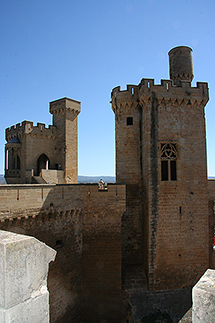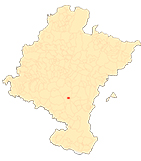The palace of Olite
By Javier Martínez de Aguirre
|
THE PALACE OF OLITE IN THE PANORAMA OF GOTHIC PALACES IN NAVARRE |
Torre de la Joyosa Guarda
The Torre de la Joyosa Guarda was built, like the Torre de las Tres Tres Grandes Finiestras, the Torre de la Ochavada and the Torre del Portal, in the second decade of the 15th century, approximately between 1411 and 1414. It has its characteristic silhouette at the southern end of the palace complex and has required less restoration work than other spaces in Olives. Its name and shape lead us to think initially of a defensive function: to serve as a watchtower from which to watch out for possible attacks on the residency program regia. However, the fact that it is located inside the town rather than outside arouses our suspicions. In reality, the name may not have been chosen for a practical purpose, but rather to evoke a legendary construction well known to Charles III and to all fans of the King Arthur story cycle. La Joyosa Guarda is the name by which Lancelot, the best of the knights of the roundtable, renamed the castle of the Guardia Dolorosa, which he was able to conquer thanks to shields with miraculous properties provided by a maiden (according to the account of Lancelot of the Lake). This castle was "one of the most beautiful buildings in the world, although it was small". Charles III had the window of the noble floor of the main room of this tower decorated with a tracery that reproduced one of his family emblems: the triple ribbon that can also be found on royal seals and in the paintings of Pamplona Cathedral. The Joyosa Guarda is, therefore, one more of the numerous references to the Arthurian world that populated both the imagination and the everyday world of King Charles III. It should be remembered that he gave the name Lancelot to one of his illegitimate sons (whose coat of arms, quartered Evreux and three bands that were probably red on a silver field, was inspired by that of the chivalric hero).












